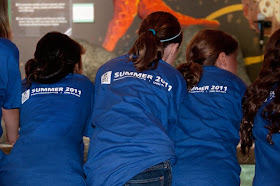
By Sarah Moore, Life Sciences Manager
Once in a while, an appointment on my calendar is so bizarre that even I wonder what kind of job I signed up for. This whole week is full of them. This week, I will “walk around picking up trash”, and check to make sure that the “butterfly cart gets restocked”. In one wacky day I have a 9:00 am “wild oceans adventure” a 10:00 am “discuss cockroach pigment with Brigid” and a 10:30 am “mist snake heads with Holly”. I end the week with “mole-rat cam follow up”.

So what do all these silly meeting topics really mean? Some of them are fairly mundane. Walk around picking up garbage is just that. Each week, a team led by our horticulture staff, Jeff and Maida, walks the grounds, cleaning up litter. We like to keep things looking their best. Some trends we have noted: people are becoming more conscientious about correctly disposing of food wrappers and bags. However, smokers, gum chewers and dog walkers can make a huge difference by packing out their litter.

Our Tropical Butterfly House is full of lovely butterflies, each with a brief but glorious two week life span. When they die, many butterfly’s wings are still colorful and pretty. Rather than destroy these intact and valuable items, we prepare them for a second existence in our Butterfly Discovery Cart, where children get to observe, appreciate, and even touch a butterfly wing.

Wild Oceans Adventure is a summer camp offered by our camp program. One of the activities campers get to enjoy is watching and participating in a tide pool feeding. Kids learn how animals eat in the wild, how we care for them here, and how to be a respectful guest next time the visit a beach.

Why on earth am I discussing cockroach pigment? There is a rumor among new staff and volunteers, that our Madagascar hissing cockroaches get more pigment and grow darker as they age. No one knows where this unverified fact began. Since it is essentially a new hypothesis, we don’t have any data on whether it is true. Brigid, who supervises our Discovery Corps program is interested in running an experiment to see what really happens.

Holly, our Presentation Supervisor, and I have been tasked with analyzing our snake handling practices, to make sure we have all possible safety measures in place. Since we know that most snake bites are related to feeding accidents, we wanted to develop a clear protocol to let snakes know when they were going to be handled but not fed. One way to do this is to lightly mist water on the snake’s face before handling. This may sound unpleasant, but our snakes relish water in nearly any form, and would develop a pleasant, but non-food related association between a refreshing mist of water and an upcoming presentation. This is in theory. Holly and I want to prototype the process and see how the snakes really react before letting our staff do it.
I’m going to let my last appointment, “discuss mole-rat cam” hang out there as a teaser for now. This article is already long enough, and I hope to have a full story on the cam in the near future.
I'm glad I found this blog, and particularly this post. I work as an educator at a science museum too and have just started a blog to talk about all the diverse and interesting things that are part of having this kind of career.
ReplyDeleteAlso, I've been having some problems with feeding our Ball Python lately, and I like your idea on misting. I always wear bright yellow rubber gloves when I feed him for the same reason.
My blog: http://sci-educator.blogspot.com/